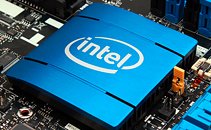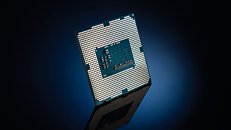Tuesday, November 27th 2018

Intel Candidly Discusses Troubles at Credit Suisse 22nd Annual TMT Conference
For years Intel was able to maintain their endless tick-tock cycle however with the switch from 14nm to 10nm Intel realized all too late that they had bitten off more than they could chew. According to Robert Swan, Intel's Interim Chief Executive Officer and Chief Financial Officer, "we set out in the transition to 10 nm to attempt to scale much faster than we ever had at a time when I think most would argue the technology and the science and the challenges are more challenging they've ever been. So, we took a fairly aggressive scaling factor, roughly 2x of what the competitors do. So, we went for the analogy that a grand slam, I think, when the competition was hitting really solid singles."
Essentially Intel had hedged their bets that they could take a revolutionary step instead of the more typical evolutionary one thereby leaving their competition behind. Instead, it's resulted in the current situation that we are all very much aware of, that Intel is far behind their original predicted schedule. While that timeline has since been revised and they are now on course to release 10nm products in 2019, and 2020 Intel has also made it known that they plan to regain their leadership position as that transition begins.In regards to supply constraints, Swan elaborated that they will continue to prioritize their Xeon product line first with their traditional small core and other devices coming second. Meaning those products will see continued supply shortages for the foreseeable future since that ties into Intel's eventual transition to 10nm. To help mitigate the issue, Intel has redeployed some of their 14nm equipment, but it is not enough to completely solve the supply problem. Right now they are trying to work with customers to figure out what constitutes actual demand rather than just inventory hoarding. Thus far Intel considers overall inventory healthy going from Q3 to Q4. For some customers this may be true, however for enthusiasts, that is not the case. Intel's latest Core 9000 series processors are in minimal supply having sold out pretty much everywhere making them little more than imaginary offerings for the PC gaming and enthusiast market. So while the inventory of certain products may be in a healthy state, you could say Intel's looking at the situation with rose-colored glasses.
You can check the entire transcript for more in-depth details from Intel at the source below.
Sources:
Seeking Alpha, Via Reddit
Essentially Intel had hedged their bets that they could take a revolutionary step instead of the more typical evolutionary one thereby leaving their competition behind. Instead, it's resulted in the current situation that we are all very much aware of, that Intel is far behind their original predicted schedule. While that timeline has since been revised and they are now on course to release 10nm products in 2019, and 2020 Intel has also made it known that they plan to regain their leadership position as that transition begins.In regards to supply constraints, Swan elaborated that they will continue to prioritize their Xeon product line first with their traditional small core and other devices coming second. Meaning those products will see continued supply shortages for the foreseeable future since that ties into Intel's eventual transition to 10nm. To help mitigate the issue, Intel has redeployed some of their 14nm equipment, but it is not enough to completely solve the supply problem. Right now they are trying to work with customers to figure out what constitutes actual demand rather than just inventory hoarding. Thus far Intel considers overall inventory healthy going from Q3 to Q4. For some customers this may be true, however for enthusiasts, that is not the case. Intel's latest Core 9000 series processors are in minimal supply having sold out pretty much everywhere making them little more than imaginary offerings for the PC gaming and enthusiast market. So while the inventory of certain products may be in a healthy state, you could say Intel's looking at the situation with rose-colored glasses.
You can check the entire transcript for more in-depth details from Intel at the source below.


24 Comments on Intel Candidly Discusses Troubles at Credit Suisse 22nd Annual TMT Conference
Is that why they sat on their hands since... Nehalem?
I dunno, man... things are looking grim for Intel, at the moment. I'm not so sure upgrading from 14nm to 10nm is going to be this fantastic thing... not without a major architecture overhaul, the likes of which not seen from Intel since Nehalem, or arguably Sandy Bridge. Skylake v6 on 10nm is not going to cut it.
As for other innovative things... Jim Keller didn't manage to surpass Intel's Core in terms of IPC, it has a marginal efficiency lead per clock over Core, and... that's it. I think its realistic to consider that we've got the basic architecture at a near-optimal state and the only gains come from optimizing it based on core counts and power targets. We're also not seeing a radically different CPU design on ARM either, its just copying over the best practices developed under x86 mostly. Can't keep reinventing the wheel and think it keeps getting more round.
That also explains very well why Intel wanted to push its node shrinks so hard: its the place where most of the gains are to be had - not architecture.
Edit:
tl;dr from what Intel said and we directly care about:
- Their current 10nm plan: end of 2019 client CPUs and FCPGAs with data center CPUs following early 2020.
- They expected single digit % rise of demand but got in teen %s, especially in datacenters with larger dies and thus larger capacity usage.
- They expected 10nm to be there and fabs were prepared. Now they brought some manufacturing capacity ready for 10nm back to 14nm (that probably took most of the mentioned $1.5B investment).
and it will be a much more imaginary offering than anyone alive now can imagine
Game of cat and mouse, in this case AMD being the cat.
Well there was the P4, then Larrabee, Atom (for smartphones & tablets) & lately 10nm, at each step they've had mountains of cash & failed spectacularly in such instances.
Also, Atom was not a failure in its days. The Zenfone 3 (if I recall correctly) was just as fast as Snapdragon oferrings of that time while consuming slightly more power. Given we are talking about an uArch optimized for low power compared to one built for 240V plug, that was quite an achievement. The reason Intel left Atom behind was the small margin of profit.
P4 was bad, I agree, but with their resources they managed to keep pace with AMD until the last very iterations of Athlon 64, where AMD had, for a brief period the performance crown.
I think we are subestimating Intel here. They have great talent, great people. They just made the wrong bet on something that is very tricky to fix and that is chip fabrication. Until now, I think they handled it pretty well, but things start to get risky for them if they don't do something in the next 6 months (when Zen 2 is rumoured to launch).
Doing for company B what you did (and worked) for company A is a recipe for disaster.
*finger guns*